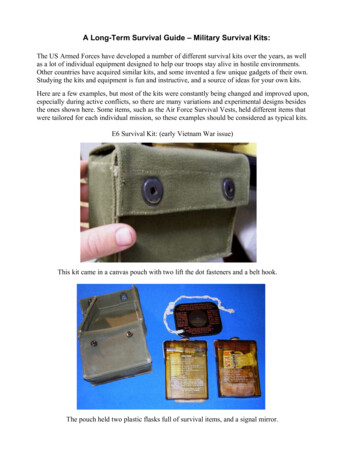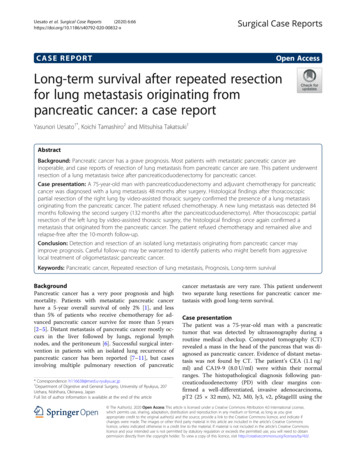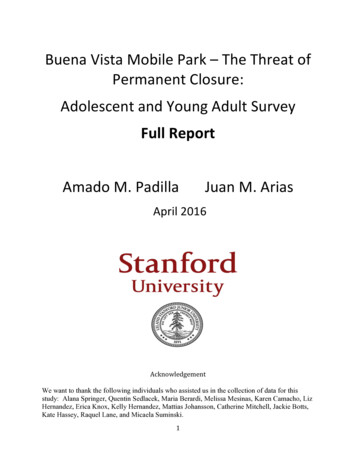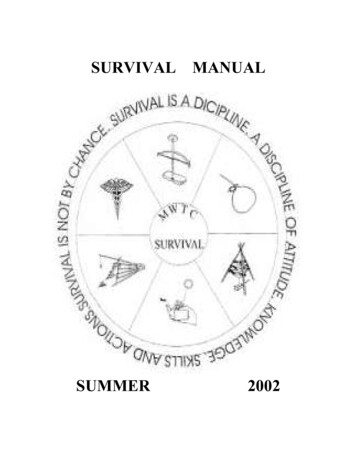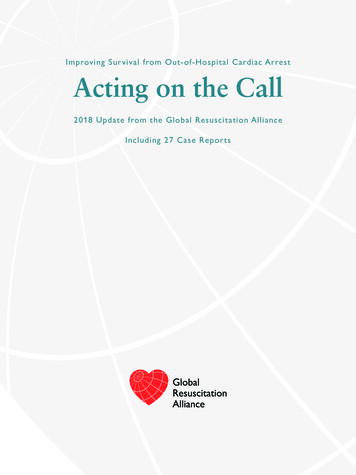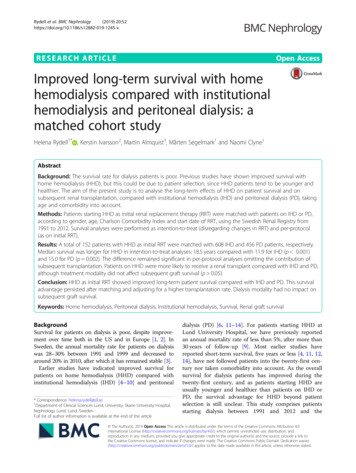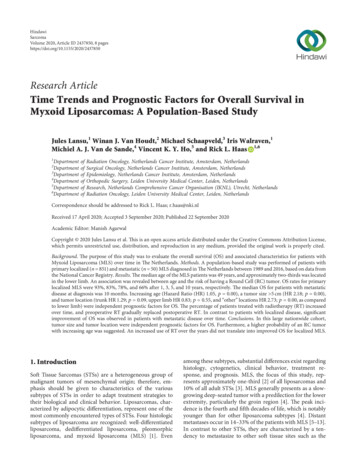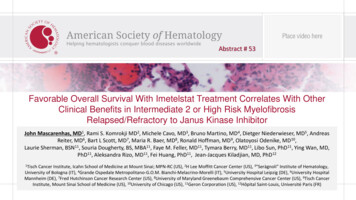
Transcription
Abstract # 53Favorable Overall Survival With Imetelstat Treatment Correlates With OtherClinical Benefits in Intermediate 2 or High Risk MyelofibrosisRelapsed/Refractory to Janus Kinase InhibitorJohn Mascarenhas, MD1, Rami S. Komrokji MD2, Michele Cavo, MD3, Bruno Martino, MD4, Dietger Niederwieser, MD5, AndreasReiter, MD6, Bart L Scott, MD7, Maria R. Baer, MD8, Ronald Hoffman, MD9, Olatoyosi Odenike, MD10,Laurie Sherman, BSN11, Souria Dougherty, BS, MBA11, Faye M. Feller, MD11, Tymara Berry, MD11, Libo Sun, PhD11, Ying Wan, MD,PhD11, Aleksandra Rizo, MD11, Fei Huang, PhD11, Jean-Jacques Kiladjian, MD, PhD121TischCancer Institute, Icahn School of Medicine at Mount Sinai; MPN-RC (US), 2H Lee Moffitt Cancer Center (US), 3”Seràgnoli” Institute of Hematology,University of Bologna (IT), 4Grande Ospedale Metropolitano-G.O.M. Bianchi-Melacrino-Morelli (IT), 5University Hospital Leipzig (DE), 6University HospitalMannheim (DE), 7Fred Hutchinson Cancer Research Center (US), 8University of Maryland Greenebaum Comprehensive Cancer Center (US), 9Tisch CancerInstitute, Mount Sinai School of Medicine (US), 10University of Chicago (US), 11Geron Corporation (US), 12Hôpital Saint-Louis, Université Paris (FR)
Disclosure Presenter: John Mascarenhas, MD Affiliations: Tisch Cancer Institute, Icahn School of Medicine at Mount Sinai, NY,USA Disclosure:– Consultancy: Celgene/BMS, Incyte, Roche, PharmaEssentia, Constellation, Kartos,Prelude, Geron, Abbvie– Research funding: CTI Biopharma, Incyte, Janssen, Merck, Novartis, Promedior, Roche,Merus, AROG, Kartos, Forbius
Background Myelofibrosis (MF) is a serious and life-threatening myeloproliferative neoplasm Patients who are relapsed after or refractory to (R/R) therapy with Janus kinase inhibitors(JAKi) have dismal overall survival (OS) of 13-16 months.1,2 Imetelstat, a 13-mer oligonucleotide that specifically targets the RNA template of humantelomerase, is a potent competitive inhibitor of telomerase enzymatic activity IMbark (MYF2001; NCT02426086) was a randomized, single-blinded, phase 2 study ofimetelstat in R/R int-2/high-risk MF patients, that evaluated two doses of imetelstat: 9.4mg/kg and 4.7 mg/kg IV every 3 weeks.–Dose-related clinical benefit, specifically in terms of symptom response and improvement in OSobserved.3–The improvement in OS for patients treated with 9.4mg/kg imetelstat was further supported byanalyses of IMbark patients with closely matched real world controls.41Kuykendall,et al. Ann Hematol 2018;97:435-441.et al. Blood 2018;132:68.5.3Mascarenhas,2Newberry,et al. Blood 2017;130:1125-1131.et al. EHA 2019 #PS1456.4Kuykendall,
Imetelstat: First-in-Class Telomerase InhibitorImetelstat Proprietary: 13-mer thio-phosphoramidate oligonucleotidecomplementary to hTR, with covalently-bound lipid tail toincrease cell permeability. Potent, first in class competitive inhibitor of telomerase:IC50 0.5-10 nM Target: selectively targets heme (MF) malignant stem andprogenitor cell proliferation.1, 2Imetelstat binds to RNA templatepreventing maintenance of telomeres (hTERT)(hTR) lipid tailShort telomere length (TL), high levels of telomerase activity(TA) and high expression of human telomerase reversetranscriptase (hTERT) correlated with higher risk, diseaseprogression and shorter OS in patients with myeloidmalignancies.3-5Nonclinical studies demonstrated that imetelstat reduces TA,hTERT expression level, and JAK2V617F hematopoieticprogenitor cells in MF patient samples, indicative ofmechanism based on-target activity.1,2Cells with high levels of TA and hTERT and short TL,represent best target for treatment with telomeraseinhibitor.1Wang,et al. Blood Adv 2018;2:2378-88.et al. Leukemia 2017;31:2458-67.3Briatore, et al. Cancer Biol Ther 2009;8:883-9.4Kishtagari and Watts. Ther Adv Hematol 2017;8:317-26.5Wang, et al. Int J Lab Hematol 2010;32:230-8.2Mosoyan,
Dose Related Clinical Benefits withImetelstat TreatmentClinical BenefitsMedian OS, months (95% CI)Symptom Response at week 24 (TSS reduction 50%), n (%)Spleen Response at week 24 (SVR 35% by IRC), n (%)Median PFS, months (95% CI)Clinical improvement, per IWG-MRT, n (%)Transfusion independence of 12 weeks, n/N (%)Reduction in bone marrow fibrosis , n/N (%) 25% Reduction in VAF of JAK2, CALR or MPL , n/N (%)4.7 mg/kg(N 48)19.9 (17.1, 33.9)3 (6.3%)014.8 (8.3, 17.1)8 (16.7%)2/14 (14.3%)4/20 (20.0%)1/18 (5.6%)9.4 mg/kg(N 59)28.1 (22.8, 31.6)19 (32.2%)6 (10.2%)20.7 (12.0, 23.2)15 (25.4%)3/12 (25.0%)16/37(43.2%)8/19 (42.1%)CALR calreticulin gene, CI confidence interval, JAK Janus kinase, IWG-MRT International Working Group – Myeloproliferative Neoplasms Research andTreatment, MPL thrombopoietin receptor gene, OS overall survival, PFS progression free survival, SVR spleen volume reduction, TSS total symptom score, VAF variant allele frequency
Objectives and Methods For Current AnalysisObjectives: To evaluate the association between overall survival (OS) and spleenresponse, symptom response and fibrosis improvement. To explore the prognostic pretreatment baseline characteristic factors on OS.Methods Spleen response: spleen volume reduction (SVR) 35% at Week 24. Symptom response: total symptom score (TSS) reduction 50% at Week 24. OS analysis was performed based on database lock in April 2020; median follow-up was 41.7months (range 0.2, 49.2).––All 107 enrolled patients (n 59 in 9.4 mg/kg arm, n 48 in 4.7 mg/kg arm) were included in ITT analysis.All correlation analyses were done irrespective of treatment dose. Bone marrow fibrosis was assessed by central pathology laboratory and graded by EuropeanConsensus method, including evaluation of reticulin and collagen changes.–Fibrosis improvement was defined as a decrease in fibrosis by 1 grade.
Potential OS Improvement with 9.4 mg/kg ImetelstatTreatment in Patients with MF R/R to JAKiOS analysis was performed based on database lock in April 2020; medianfollow-up was 41.7 months (range 0.2, 49.2)Similar results were observed when sensitivity analyses accounted for confounding factors of subsequent therapies, includinghematopoietic stem cell transplantation and dose escalation from 4.7 mg/kg to 9.4 mg/kg
Lower Risk of Death Significantly Correlates with ImprovedBone Marrow Fibrosis in Patients Treated with Imetelstat Dose related improvement in bone marrow fibrosis Patients with improved or stable bone marrow fibrosis had lower risk of death than thosewho had worsening bone marrow fibrosisBone marrow fibrosis improvement, n/N (%)4.7 mg/kg9.4 mg/kg4/20 (20.0%)16/37(43.2%)**N: 57 pts had baseline and at least one post-baseline bone marrow fibrosis assessment irrespective of dose.Bone marrow fibrosis was assessed by central pathology laboratory and graded by European Consensus method, including evaluation of reticulin and collagen changes.Fibrosis improvement was defined as a decrease in fibrosis by 1 grade.
Patients with Symptom Response Trend toHave Lower Risk of DeathDose-dependent symptom response: higher responserate seen in 9.4mg/kg arm than in 4.7 mg/kg armPatients who achieved symptom response demonstrated a trend of lowerrisk of death compared to those who did not achieve symptom response32.2%6.3%patientsN: Number of patients in each (reference or non-reference) category irrespective of dose.Symptom response: 50% total symptom score reduction at Week 24Deaths: Number of deaths in each category.Hazard ratios (HR) and p-values are based on Cox regression models with Imtelelstat treatment cohort andresponse category as factors.TSS: total symptom score
Patients with SVR Trend to Have Lower Risk of DeathDose-dependent spleen volume reduction (SVR)at week 24 or at any timeSpleen volume reductionMax SVR at any time: 10%Responders (%)95% CIMax SVR at any time: 20%Responders (%)95% CIMax SVR at any time: 35%Responders (%)95% CISVR at week 24: 10%Responders (%)95% CISVR at week 24: 20%Responders (%)95% CISVR at week 24: 35%Responders (%)95% CI4.7 mg/kg(N 48)9.4 mg/kg(N 59)9 (18.8%)(8.9%, 32.6%)32 (54.2%)(40.8%, 67.3%)5 (10.4%)(3.5%, 22.7%)20 (33.9%)(22.1%, 47.4%)1 (2.1%)(0.1%, 11.1%)7 (11.9%)(4.9%, 22.9%)4 (8.3%)(2.3%, 20%)22 (37.3%)(25%, 50.9%)1 (2.1%)(0.1%, 11.1%)13 (22%)(12.3%, 34.7%)0(0%, 7.4%)6 (10.2%)(3.8%, 20.8%)Patients who achieved at least 10% SVR demonstrateda trend of lower risk of death compared to those who did notN: Number of patients in each (reference or non-reference) category irrespective of dose.Deaths: Number of deaths in each category.Hazard ratios (HR) and p-values are based on Cox regression models with Imtelelstat treatment cohort andresponse category as factors.SVR, spleen volume reduction.
Predictive Disease Characteristics for SurvivalAfter Imetelstat TreatmentPretreatment DIPSS high risk, ECOG performance status, transfusion dependency, response to last JAKi,higher baseline neutrophils, lower baseline Hb and platelet values correlated with increased risk of deathN: Patients on both doses were pooled for this analysis irrespective of dose.Deaths: Number of deaths in each category.Hazard ratios (HR) and p-values are based on Cox regression models with Imtelelstat treatment cohort and demographic or baseline characteristic as factors.CI: clinical improvement.
Conclusions Imetelstat showed dose-related improvement in OS in patients who are R/R to JAKi.The survival benefit observed with imetelstat was supported by the trend of correlation with otherclinical benefits.–With a median follow-up of 41.7 months, the median OS was 28.1 months for the 9.4 mg/kg arm (95% CI: 22.8, 31.6) and 19.9 monthsfor the 4.7 mg/kg arm (95% CI: 17.1, 33.9).–There was statistically significant correlation between bone marrow fibrosis improvement and lower risk of death, which togetherwith the clinical data for improved survival suggests that imetelstat has disease modifying activity.–Patients who achieved symptom and spleen response at week 24 showed trend of longer OS compared to patients who did notachieve response–Pretreatment DIPSS high risk, ECOG performance status, transfusion dependency, response to last JAKi, higher baseline neutrophils,lower baseline Hb and platelet values correlated with increased risk of death. The Phase 3 study (IMpactMF, NCT04576156) of imetelstat in patients with refractory myelofibrosiswith primary endpoint of OS is expected to be open for screening and enrollment in Q1-2021.
Phase 3 Study DesignTreatment PeriodScreeningUntil disease progression, unacceptable toxicity,consent withdrawal(N 320)Stratification factors1) int2 vs HR DIPSS2) platelet 150 vs 150x109/LImetelstat9.4 mg/kg every 21 days2:1Refractory MFInt2/High-RiskRandomization(28 days)Post-TreatmentFollow-upEnd of TreatmentVisitwithin 30 dayspost-last doseBest Available TherapyInvestigator - selectedNon-JAK inhibitor therapyIf PD, eligible forcrossover toImetelstatPrimary Endpoint: Overall SurvivalPostTreatmentFollow up
AcknowledgementsThe authors thank all the patients for their participation in thisstudy and acknowledge the collaboration and commitmentof all investigators and their staff
Favorable Overall Survival With Imetelstat Treatment Correlates With Other Clinical Benefits in Intermediate 2 or High Risk Myelofibrosis Relapsed/Refractory to Janus Kinase Inhibitor Abstract # 53 John Mascarenhas, MD1, Rami S. Komrokji MD2, Michele Cavo, MD


